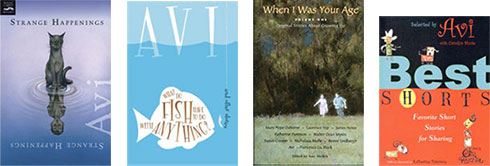Over the years, I have written a number of short stories. There are two collections, Strange Happenings (five stories) and What Do Fish Have to Do with Anything? (seven stories). Now and again, I have contributed to various thematic anthologies, some seven (I think) in number, including When I Was Your Age.
A few years ago I was able (along with co-editor Carolyn Shute) to produce an anthology of short stories for kids titled Best Shorts. There were many good stories we did not have room to include. To my taste, no one has written better short stories than Kipling’s Mowgli and Kenneth Grahame’s The Reluctant Dragon.
There was a time when the short story was a powerful force in American writing. True, that was also the time when there were many magazines who published them, and presumably millions who read them. Writing short stories was considered the normal progression for a writer who might then be discovered and/or move on to novels. That has changed.
Yet to write a good short story is extremely challenging, and takes great skill. I suspect that young people, particularly in middle and high school, are far more capable of writing good short stories than novels. I can imagine a teacher starting off each day in class with a short story.
These days—in classrooms—there is a great emphasis on the novel. Indeed, there is “Write a novel in a month,” program which I know some schools have promoted. Why not a “Write a short story in a month?” Perhaps that would be a more productive program for young people. Schools could produce their own collections of short stories as an incentive.
Maybe we should construct a list of good short stories—a list long enough so a teacher, librarian, or parent could actually read one each day to kids. A good short story can have a long life.

11 thoughts on “Short Story Collection”
Remember the literary magazine? Even high school English departments used to publish one once a year full of short stories and poems by students. Perhaps that would be a good way to bring back the artform.
I liked Storyworks when I taught elementary level students. I bought classroom copies, so I could reuse stories from year to year. I filed them by subject and content. One of my favorites, “As the Worm Turns” was filed in the science section, in the folder “worms”. I pulled it out when we did our earthworm experiments. Some stories I used for their themes, and some for content, like historical events or people. Avi is right. Sometimes a smaller chunk of writing is exactly what we need.
Writing a story is a complex project. Teachers, before you ask students to write a story, write one yourself. Before you assign a report, write one to meet the standards you’re expecting from the child. That will help you understand what tools/concepts he needs to accomplish the task.
Writing is only part imagination and magic. It requires skills that need to be modeled, taught, and practiced. A lot of teachers allow students to write ad infinitum without going back to revise, edit, and polish. In my mind, that takes away their purpose and devalues the importance of what they have to say.
I think this is a fabulous idea.
When thinking of short stories only scary ones came to mind! I think children love scary stories though so I vote for Monkey’s Paw and one called “Where the deer are” which is by Caroline B Cooney and might be more young adult.
I would recommend The Marching Morons by C.M. Kornbluth. It’s a futuristic tale, originally published in 1951, about economics, social dynamics, population control, and class assumptions. I believe grades 7 and up would get quite involved in a discussion about this, as well as the writer who predicted a social conundrum more than 60 years ago. For certain interested readers, this could also be a good introduction to the wealth of stories from The Golden Age of Science Fiction. The Marching Morons is in the public domain: http://mysite.du.edu/~treddell/3780/Kornbluth_The-Marching-Morons.pdf
Love this idea. There are several teachers at the middle school where I work that teach with short stories. One does a study on Bradbury. Another uses classics by Twain, Hawthorne, plus The Necklace, The Veldt etc i introduced him to my favorite: A Rose for Emily by Faulkner. The kids love that one. He often comes to me to find something new. I have a large short story collection. Love the guys read anthologies. Just today a counselor came to me asking for a short story to introduce the ‘lift up letters’ campaign they are doing. And i gave two teachers whose students are writing ahort stories now! I created sites where they could share them and had them create ‘book trailers’ for each others’ stories. How about we use a collaborative document? Be happy to create and share.
We’ve put up a Google Form. Please add your recommendations. Links in the article above.
Some of my favorites:
“The Things They Carried” Tim O’Brien
“Lamb to the Slaughter” Roald Dahl
“The Necklace” Guy de Maupassant
“The Gift of the Magi” O. Henry
“Story of an Hour” Kate Chopin
“The Ransom of Red Chief” O. Henry
“A White Heron” Sarah Orne Jewett
“The Sun, the Moon, the Stars”
Junot Diaz
This is a great idea! I’m looking forward to seeing everyone else’s favorites.
Love the idea! Might want to try a Google form to collect all the suggestions and include categories such as title/author/description/grade level(s)
We’ve put up a Google form. Please add your recommendations!
Here is a an index of nearly 1400 great short stories. http://readmeastoryink.com/